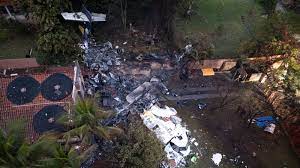By: Coco Xu
On August 9, 2024, a VoePass plane en route to Sao Paulo, Brazil, plummeted 17,000 feet from the sky, crashing into a community in the town of Vinhedo shortly before reaching its destination. All 62 people on the plane, including 58 passengers and 4 crew members, perished. No one on the ground was harmed.
Brazilian investigators have begun looking into the cause of the crash, which remains unknown due to a complete lack of communication before the plane started falling. Footage of the incident showed the plane spinning slowly while falling on its underside. Aviation experts said that this is a clear indication that the plane had stalled, meaning it had lost the lift required to maintain its altitude. “You can’t get into a spin without stalling,” said John Cox, a former pilot of 25 years who now works to investigate plane crashes, according to The New York Times.
However, the reason the plane stalled is unclear. The most popular theory is severe icing, which refers to the buildup of ice on parts of the plane that hampers its functionality. “The way the aircraft fell, spinning out of control, is characteristic of someone who lost the functionality of the wing and the aircraft controls,” said Celso Faria de Souza, a Brazilian aeronautical engineer and forensic expert in plane crashes. “This can happen because of ice.”
Mr. Cox said that the plane was traveling at the approximate speed of 325 miles per hour before its speed fell dramatically prior to the crash. However, its speed had not dropped far enough to cause a stall by itself, meaning that icing had likely played a major role in the stall. “If there is enough ice, then it changes the shape of the wing, and that could cause it to stall at a much higher speed,” he said.
Even then, icing itself does not explain why the plane stalled. The threat of icing is by no means a new concept; pilots are equipped with countless methods to deal with it, like icing alerts and thawing systems. If the alerts malfunctioned, pilots should have seen the ice building up on the plane. If the thawing systems did not work, pilots could lower the plane’s altitude so that warmer air can melt the ice.
Under normal circumstances, pilots would inform air traffic controllers if they were to lower the plane’s altitude. However, controllers received no indication about any kind of emergency before the plane crashed. “They may have tried to speak and the radio failed, the communication failed,” said Joselito Paulo, president of the Brazilian Aviation Security Association. “Or they made the communication, but it wasn’t intercepted by air traffic control.”
Investigators have located one of two of the plane’s black boxes, which contain flight data and recordings from the cockpit, respectively, and are now probing it for details on the crash. This information will prove crucial in not only discovering the cause of this crash, but also in preventing similar catastrophes from happening in the future.











